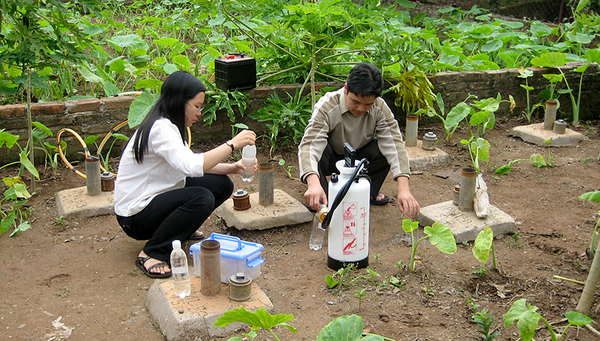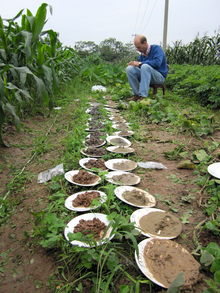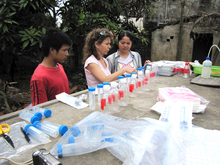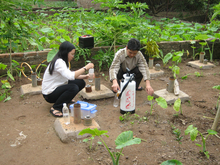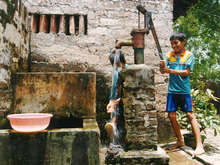Archive detail
Massive groundwater withdrawals promote arsenic transport into an uncontaminated aquifer
September 11, 2013 |
A study carried out near Hanoi by researchers from the US, Switzerland and Vietnam indicates that excessive pumping of groundwater poses a long-term threat to millions of people. According to lead author, Professor Alexander van Geen of Columbia University, the study published in Nature today demonstrates for the first time that a clean aquifer can be contaminated by accelerated flows of groundwater containing high levels of arsenic. Although the movement of arsenic contamination is slow, the process appears to be unstoppable.
Hanoi is expanding at a pace typical of many metropolitan areas worldwide, and pumping for municipal water supplies doubled between 2000 and 2010, to around 900 million litres a day. In the city, water is treated and filtering ensures that any arsenic is largely removed. However, this only solves the problem if water users are connected to the municipal supply, which is not the case in many suburban areas. Here – for example, near the Red River – water for household use is pumped from numerous private wells and does not undergo treatment. In the past, high water levels in the safe aquifer have ensured that water pumped from these wells is free of arsenic. But as a result of Hanoi’s growing groundwater withdrawals, flow conditions have changed: contaminated water from arsenic‑rich sediments and from the river is now increasingly intruding into the previously uncontaminated aquifer.
Co-author Michael Berg, a geochemist at Eawag, comments: “It’s a huge, unintended experiment. We are altering systems all over the world.” He believes that processes similar to those observed around Hanoi – involving not only arsenic but also other contaminants – may be under way in other areas, such as the megacities of Dhaka (Bangladesh) and Beijing (China). But fundamental changes in groundwater conditions could also occur in regions where large amounts of water are pumped for irrigation, e.g. in parts of sub‑Saharan Africa or arid areas of North America.
At some of the sites investigated near Hanoi, arsenic concentrations in groundwater are already 10–50 times higher than the guideline level of 10 µg/L recommended by the World Health Organization. Other sites have yet to be affected by geogenic arsenic contamination: according to Professor Rolf Kipfer of Eawag, who measured groundwater ages using helium and hydrogen isotope dating techniques, the movement of dangerous arsenic levels is much slower than the migration of groundwater itself. While, over the last 40–60 years, water from the contaminated aquifer has migrated more than 2 kilometres towards the city centre, arsenic contamination has only advanced around 120 metres. This means that, where water quality is still acceptable today, sufficient time remains for water managers to address the problem – by reducing withdrawals or introducing water treatment. However, as Berg points out, “Arsenic contamination is constantly moving, and as it continues to advance, more people are exposed.”
Arsenic
Arsenic is one of the most common inorganic contaminants found in drinking water worldwide. This metalloid occurs as a natural component of sediments, with small quantities being dissolved in groundwater as a result of weathering. The inorganic salts of arsenic are tasteless and odourless, but highly toxic to humans. If ingested over long periods, even low concentrations can cause damage to health, including hyperpigmentation of the skin, hyperkeratosis on the palms and soles, disorders of liver, cardiovascular and kidney function, and various types of cancer.
Problems arise from the fact that firstly, arsenic concentrations can vary widely at the local level and, secondly, people in many areas are completely unaware of the risk because their groundwater wells have never been screened for arsenic. Concentrations below 10 µg/L are considered safe. This concentration is therefore recommended by the World Health Organization as a guideline value for arsenic in drinking water.
Original publication:
Alexander van Geen, Benjamín C. Bostick, Pham Thi Kim Trang, Vi Mai Lan, Nguyen-Ngoc Mai, Phu Dao Manh, Pham Hung Viet, Kathleen Radloff, Zahid Aziz, Jacob L. Mey, Mason O. Stahl, Charles F. Harvey, Peter Oates, Beth Weinman, Caroline Stengel, Felix Frei, Rolf Kipfer, Michael Berg. Delayed contamination of an aquifer with high-arsenic groundwater drawn by municipal pumping in Vietnam. Nature 501(7466). doi:10.1038/nature12444.
Photos for download
Only to be used in connection with this media release and not to be archived.
Lead author of the study, Prof. Alexander van Geen, sampling sediments at the field site near Hanoi.
(© Eawag)

